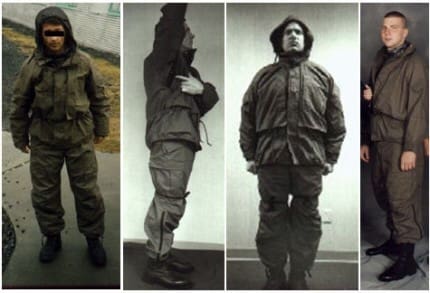Long before Wolf Grey there was something else. In the early 1990s Army Special Operations Command experimented with a layered clothing system called Battle Dress System. Leveraging lessons learned from the original Extreme Cold Weather Clothing System (ECWCS), it featured a Capilene Next to Skin layer, Fleece mid-layers including a bib and jacket, a Gore-Tex undergarment and an outer layer called the SOF BDU. The underlayers were all Black and eventually became the Lightweight Environmental Protection (LEP) component of SPEAR.
It was quite popular with those that used it, offering material and design improvements over ECWCS which was just beginning to see widespread fielding.

The SOF BDU was a solid grey combat jacket and trouser. These were essentially over garments that were intended to be worn as an outerlayer, over any combination of the other components depending on the weather. The material was new and consisted on Nylon, Cotton and Kevlar for increased abrasion resistance. The design of the jacket was unlike anything else in the inventory with large Napoleon pockets on the chest and a hood that could be stored in the collar. It also boasted pit zips for ventilation, a rank tab on the chest and pockets mounted on the sleeves. The pants were quite similar to the M1950 field trouser and incorporated thigh tapes designed to help stabilize the load in the cargo pockets. They also added a zippered lower leg opening in order facilitate donning and doffing.
Today, when readers learn about BDS and the Charcoal colored Gore-Tex undergarment they are surprised that it wasn’t the outer most layer but beginning in the mid-80s there were lightweight 3-layer undergarments available commercially. This was before ECWCS or other camouflage shells were commonly available. The Gore undergarments were used by a variety of troops and worn under their BDUs in order to maintain camouflage. It also gave them a lightweight waterproof breathable layer.
With its solid grey color the item was rejected, primarily due to institutional prejudice. When LEP was adopted finally adopted later in the decade, it was without the SOF BDU.


I remember either US Cavalry or Ranger Joes selling the goretex under layer. I never knew where that idea originated until this article was first published. Interesting idea but can you imagine the weight of the soaked cotton uniform? Not to mention I’m sure the soakedbuniform would have cut down on the breathability of the underlying goretex. Was it not possible to manufacture it in an M81 pattern at the time? What drivenut to be an under layer?
The use of goretex as a button in or underjacket liner was in use by the Dutch and British army. In early mid 90s in the British military this was often to protect the expensive goretex liner from branches etc. Also so that the stuff we carried in pockets in our smocks were still all where they were and were not obstructed or need to be moved up to the outer layer
I’ve always wondered- “why grey?” What are the qualities of that color which have led us towards its use in uniforms since the Civil War?
It is my understanding that it is quite neutral and therefore can blend in, to varying degrees, with many backgrounds.
My understanding is that at Natick labs, there has/had been a “movement” or institutional “pet rock” for grey uniforms, with origins dating back to the 1970’s. Someone thought that the “Field Grey” uniforms of the German army in WW I and WW II represented the ideal universal camouflage.
Perhaps they were on to something, if watching for an enemy 300 meters distant in the cold fog and haze of a Central European morning represents the universal camouflage environment.
As to this SOF uniform being rejected because it was grey in color, wow, what a failure of imagination! I’m sure the manufacturer would have been equally happy to make it in the proverbial pink polka dots, it requested.
Goes a long way to highlighting the importance of making your demonstration sales samples look (in color and “style”) just like a familiar and accepted item, especially when selling to the military! Look at the radically new Sikorski/Boeing tandem rotor helicopter prototype for example – painted the same color as current Army aircraft, just to psychologically reassure certain child-like (but influential) elements of the target audience that “See? This won’t bite. It’s yummy…here, try some!”
So this was a predecessor of our early-mid 2000’s PCU? Our original issue was in an Alpha-type gray, Lvl 5 was made by Patagonia (Shitty quality) and the Goretex. I liked the Sekri Lvl 3 furry jacket and the Lvl 7, decent quality. If SPEAR could just ditch Patagonia and use an actual quality manufacturer the boys would approve and not have to waste their own money on better Crye and Arc’teryx made products. My $0.02.
The Germans currently issue waterproof garment to be worn under the camo uniform. I believe they call it the “Unterzieh Nässeschutz”.
I’ve seen that a lot with the Canadian Forces called the “stealth suit”. Wearing this under the camo does reduce noise a fair bit. Can’t remember if was issued or just a pretty common personal purchase.
The stealth suit is quasi issued, private purchase for the individual troop, but part of the kit issued to snipers. However, the CF has moved forward and issued a goretex jacket like every other country albeit 25 years after everyone else.
I wish someone would revive this system completely! We have to rely on traditional mountaineering companies who have no say in designs.
This would be a true survival clothing system.
Cool article. Although I keep getting distracted by the dude on the far right with three hands.
Bet he could chuck nades like nobody’s business.
I had a set of the under-BDU Gortex, I loved them when I wore them when training at Ft Lewis.